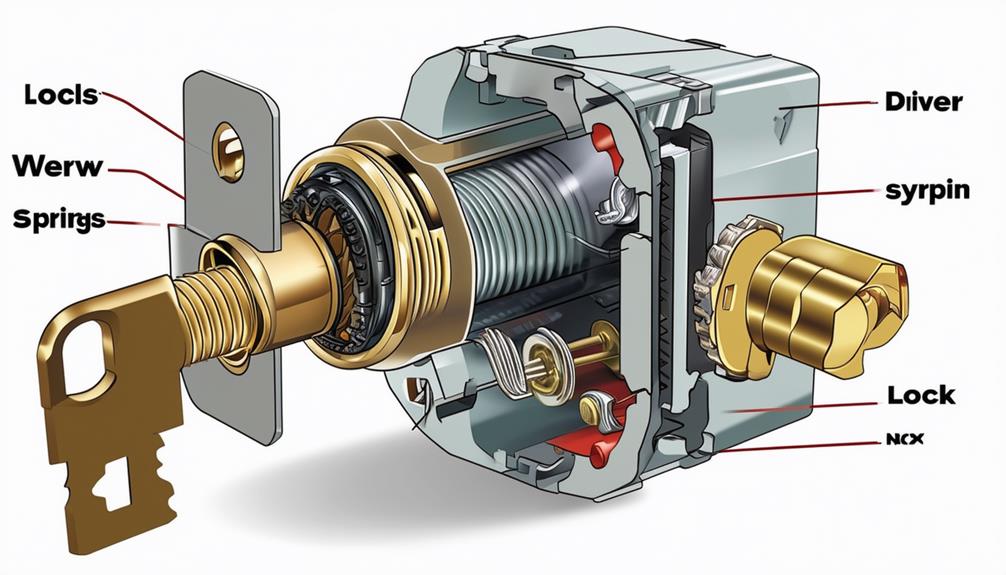Access the world of lock bypassing with beginner-friendly techniques. Start with a bump key, striking and turning while applying pressure. For a hands-on approach, try lock picking with tools like a tension wrench and various picks. Experiment with the shim technique using a thin metal piece to manipulate pins. Impressions can create a working key without damage, requiring patience and precision. Decoding locks demands comprehension and tools like decoding keys. Disguised entry techniques offer access opportunities with effective disguises. Discover these essential DIY skills to master the art of lock bypassing.
Key Takeaways
- Understand lock mechanisms, especially the pin tumbler system.
- Utilize bump keys with caution for specific pin tumbler locks.
- Invest in quality lock picking tools for better success.
- Explore shim technique with gentle manipulation for lock bypassing.
- Practice impressioning for non-destructive access using a blank key.
Understanding Basic Lock Mechanisms

Lock mechanisms are at the core of home security. As a beginner in lockpicking, it's vital to grasp the basic concepts behind how locks function. Most traditional locks operate using pin tumbler mechanisms, which have a long history, with their origin traced back to ancient Iraq.
These locks have a series of pins of varying lengths within the cylinder. When the correct key is inserted, it aligns the pins at the shear line, allowing the cylinder to turn and the lock to open. Understanding the security measures and vulnerabilities associated with pin tumbler locks can also aid in your lockpicking journey.
Understanding the inner workings of a lock is essential for anyone interested in lockpicking. By comprehending how pins interact within the cylinder, you can begin to develop the skills needed to manipulate them effectively.
Practice is key in honing your lockpicking abilities. Start with simple locks and progressively challenge yourself with more complex ones as you gain experience.
Using a Bump Key

If you're delving into the world of lock bypassing techniques, one method you may come across is the use of a bump key. A bump key is a specially crafted key that, when used correctly, can help you open certain types of pin tumbler locks.
This technique involves inserting the bump key into the keyway and then striking it with a hammer or similar tool while applying slight pressure to turn the key. The idea behind using a bump key is to momentarily jostle the pins inside the lock, causing them to jump and allowing the key to turn and open the mechanism.
It's vital to master safe practices for all when experimenting with this technique, as ethical lock picking emphasizes responsibility and legality.
It's important to note that bump keys aren't universal and must be cut to fit a specific type of lock. Additionally, using bump keys on locks you don't own or without permission is illegal and unethical.
While bump keys can be effective, they require practice and skill to use successfully. If you're interested in learning more about bump keys, it's vital to approach this knowledge responsibly and ethically.
Employing Lock Picking Tools

Now, let's talk about employing lock picking tools.
First, you'll find a tool selection guide to help you choose the right tools for the job.
Understanding the fundamentals of lock picking is essential for selecting the appropriate tools and techniques.
Then, a technique demonstration will show you how to effectively use these tools to bypass locks.
Tool Selection Guide
When selecting tools for bypassing locks, it's vital to take into account the specific mechanisms you'll encounter. To effectively employ lock bypass techniques, you'll need a basic set of tools.
Start with a tension wrench, essential for applying the necessary pressure to turn the lock. Pair this with a lock pick, which comes in various shapes and sizes to manipulate the internal components of different locks.
Hook picks are great for single-pin picking, while rake picks work well for quickly manipulating multiple pins. A half-diamond pick is versatile and suitable for various lock types.
Consider adding a key extractor tool to your kit to remove broken keys stuck inside locks. Remember, quality tools make a significant difference in your success rate, so invest in sturdy, well-crafted tools that will last.
Practice using these tools on different locks to hone your skills and become proficient in bypassing various locking mechanisms.
Technique Demonstration
For successfully employing lock picking tools, understanding the specific techniques is essential. When it comes to safe DIY lock picking, following proper procedures is vital. Here are four key tips to help you master the technique:
- Use the right tools: Invest in high-quality lock picking tools that suit the type of locks you'll be working on. Having the correct tools can make a significant difference in your success rate.
- Practice patience: Lock picking requires a steady hand and patience. Rushing the process can lead to mistakes and potential damage to the lock.
- Learn the basics: Start by understanding the basic principles of how locks work. This knowledge will help you identify the components you need to manipulate when picking a lock.
- Practice on different locks: To improve your skills, practice on various types of locks. Each lock may require a slightly different technique, so gaining experience with different locks is vital for mastering the art of lock picking.
Trying the Shim Technique

To bypass a lock using the Shim Technique, you will need a thin piece of metal, such as a bobby pin or a specially designed shim tool. This technique involves inserting the shim between the lock's pins and the barrel, manipulating the pins to open the lock. Follow these steps to attempt the Shim Technique:
| Shim Technique Steps | Description |
|---|---|
| 1. Assess the lock | Examine the lock type and size to determine the best shim tool to use. |
| 2. Insert the shim | Slide the shim gently into the bottom of the keyway, ensuring it reaches the pins. |
| 3. Jiggle the shim | Wiggle the shim up and down while applying slight pressure towards the barrel. |
| 4. Turn the shim | Slowly rotate the shim as if it were a key, mimicking the release motion. |
| 5. Test the lock | After manipulating the pins, attempt to turn the lock to see if it opens. |
Exploring Impressioning

Let's talk about impressioning, a technique that involves creating a working key for a lock by making impressions on a blank key. This method is particularly useful for locks that are more complex, as it allows for a non-destructive approach to gaining access.
To get started, you'll need specialized tools like files, magnifying glasses, and a vice to securely hold the key. The step-by-step process of impressioning requires patience and precision to gradually refine the key until it successfully opens the lock.
For those interested in lock mechanics, understanding the mechanics of pin tumbler locks can provide valuable insights that enhance your impressioning skills.
Impressioning Tools Explained
Occasionally, when exploring the world of lock bypassing techniques, you may come across the fascinating method known as impressioning.
Impressioning Tools Explained
- File Set: An essential tool used to file down the key to create marks on the key blank.
- Blank Keys: These are the key blanks that you'll be working on to create a functioning key.
- Magnifying Glass: A vital tool to closely examine the marks left on the key.
- Marker or Paint: Used to highlight the marks on the key for easier identification.
Impressioning involves creating a working key by making impressions on a blank key using the pins inside the lock.
With the right tools and technique, you can craft a key that fits the lock perfectly.
Remember, patience and precision are key when impressioning.
In the next section, we'll explore the step-by-step process of impressioning to further enhance your understanding of this intriguing technique.
Step-by-Step Impressioning Process
The Step-by-Step Impressioning Process explores the intricate art of impressioning, offering a detailed guide on how to create a working key through precise markings on a blank key.
To begin this beginner lockpicking guide, you'll need a blank key, a file, and a magnifying glass.
- Insert the blank key into the lock you wish to create a key for.
- Turn the key back and forth while applying slight pressure. This will help the key make impressions of the internal pins.
- Remove the key and examine it closely with the magnifying glass. Look for tiny marks where the pins have made impressions on the key.
- Use the file to gently file down the areas where the marks are visible.
- Repeat the process of inserting the key, examining the marks, and filing down until the key can smoothly turn the lock.
Utilizing Decoding Methods

Utilizing Decoding Methods
To bypass locks, one effective technique is utilizing decoding methods. Decoding involves understanding how a lock works and determining the correct combination or key pattern to open it. A solid foundation in lock mechanics can greatly enhance your decoding skills, as mastering advanced techniques can lead to more effective results advanced lock picking techniques.
Here are some lock bypass tips using decoding methods:
- Understanding Lock Mechanisms: Learn about different types of locks and how they function to identify vulnerabilities that can be exploited during decoding.
- Using Decoding Tools: Utilize tools like decoding keys, decoders, or lock pick sets to help decipher the lock's internal components and find the right combination.
- Practice Patience and Precision: Decoding locks requires patience and precision. Take your time to carefully analyze the lock and make accurate adjustments while decoding.
- Seek Professional Guidance: If you're new to decoding methods, consider seeking guidance from experienced locksmiths or online tutorials to improve your skills and understanding.
Practicing Disguised Entry

If you want to enhance your lock bypassing skills, one effective technique to contemplate is practicing disguised entry. This method involves gaining entry into a locked space without drawing attention to yourself or raising suspicion. By mastering the art of blending in and appearing as if you belong, you can access restricted areas without alerting anyone to your presence.
To better understand the concept of disguised entry, take a look at the following table:
| Disguise Type | Description |
|---|---|
| Maintenance Worker | Dressing up as a maintenance worker can give you access to various buildings and facilities. |
| Delivery Person | Carrying a package or wearing a delivery uniform can help you enter secure locations with ease. |
| Janitorial Staff | Posing as a janitor allows you to move around buildings unnoticed and access locked rooms. |
| Office Staff | Dressing professionally and carrying a briefcase can help you blend in with employees and gain entry to office spaces. |
Frequently Asked Questions
Can These Techniques Be Used on Any Type of Lock?
Yes, these techniques can generally be used on a variety of locks, but it's essential to recognize that specific locks may have unique vulnerabilities or features that could affect their susceptibility to bypassing.
It's vital to understand the limitations and risks associated with each technique before attempting to use them on any type of lock.
Always proceed with caution and consider the legality and ethics of bypassing locks.
Are These Methods Legal to Use in All Situations?
When it comes to the legality of these methods, it's essential to know the laws in your area.
Always make sure you're using these techniques responsibly and ethically. Ignorance of the law is no excuse, so educate yourself to avoid any legal troubles down the road.
How Long Does It Take to Learn These Skills?
Learning these skills can vary based on your dedication and practice. Typically, it may take a few weeks to grasp the basics and start applying them effectively.
However, becoming proficient in lock bypassing could take several months of consistent effort.
What Are the Risks Associated With Lock Bypassing?
Releasing doors with ease might sound like a breeze, but beware of the risks.
When it comes to lock bypassing, you could be trespassing into legal trouble. Intruding into restricted areas or tampering with locks can lead to fines or even jail time.
Can These Techniques Be Used in Emergency Situations?
Yes, these techniques can be utilized in emergency situations. They offer a quick solution when time is of the essence.
By learning basic lock bypassing methods, you can potentially access a locked area to provide help or escape danger.
Remember, practice is key to mastering these skills and using them effectively in high-pressure scenarios.
Stay prepared and stay safe.
Conclusion
So, now you've got the knowledge to bypass locks like a pro! Remember, just like picking a lock, sometimes in life you need to find the right key to access your full potential. Keep practicing and honing your skills, and soon you'll be able to navigate any obstacle that comes your way with ease. Happy lock bypassing!









